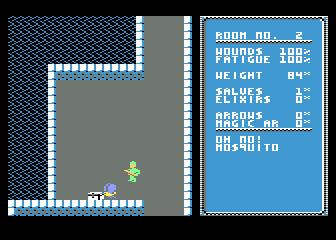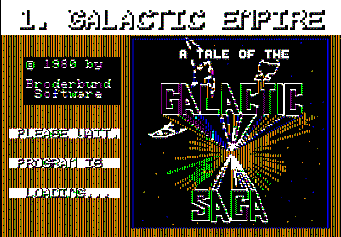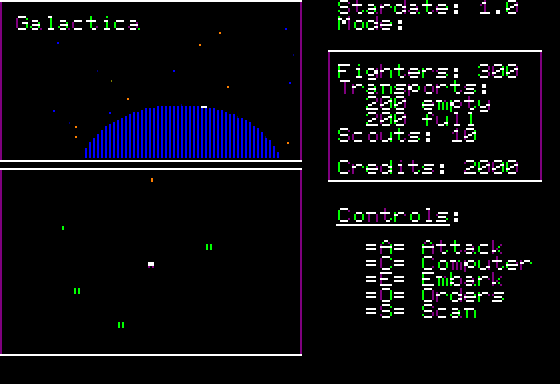|
| |

1979 Winners
Breakout

Atari Corporation, © 1979
Star Raiders

Publisher: Atari
Developer: Doug Neubauer
Original PC Platform: Atari 400/800
Ported Platforms: Atari 2600, Atari 5200
Collecting Fact: In early production runs, Star Raiders cartridges were
actually labeled "Star Raider." Since it was one of the first games available
for Atari computers and because of its popularity, neither version is particularly rare.
Summary: Star Raiders is the seminal space combat simulator. Innovative,
fun and addictive, Star Raiders is not only one of the earliest mass-market computer
games, it is also one of the biggest early success stories. Although the first
commercially viable home computers were released in 1977 (Apple II, TRS-80 and arguably
the Commodore PET), the computer gaming industry didn't take off until Atari entered the
market in 1979 with the Atari 400 and 800 computers. Star Raiders was the flagship game
for those systems, and anyone involved with computer gaming in 1979 likely
holds a special place in their memory for Star Raiders.
The object of Star Raiders is to lead the Atarian Federation to victory over the deadly
Zylon Empire. Star Raiders is unlike anything the home gaming world had seen
previously. It is a mixture of arcade and strategy and uses innovative first-person
graphics to really involve players in the game. First-person perspective was originally
used by Atari in the 1976 Night Driver arcade game, but it had never been applied to a
home space shooter before. The first-person perspective and the vast array of controls
(radar, shields, navigation, etc.) made possible by using the computer's keyboard combine
to make Star Raiders the first space combat simulation and not just another arcade game.
Temple of Apshai

Publisher: Automated Simulations/Epyx
Developer: Jim Connelley, Jon Freeman
Original PC Platform: Commodore PET
Ported Platforms: TRS-80, Apple II, Atari, C-64, Atari ST, Amiga, Intel
Collecting Fact: There are several other games in the Dunjonquest family
(Morloc's Tower, Sword of Fargoal, The Datestones of Ryn, Hellfire Warrior, Gateway to
Apshai, Curse of Ra, Upper Reaches of Apshai, and the Temple of Apshai Trilogy), but
Temple of Apshai is the original. Many of the boxes have deceiving copyright dates
on them. For example, Temple of Apshai's box says 1980, but the media inside usually
says 1979.
Summary: The version most early computer gamers are familiar with is
probably The Temple of Apshai Trilogy, which was a 1985 re-release from Epyx of three
Apshai games (Temple of Apshai, Upper Reaches of Apshai and The Curse of Ra). Aside from
better graphics, the games remained basically the same. All of the Apshais are
prototypical early computer RPGs -- nominal plot and lots of monsters to kill and
treasures to collect. As you delved deeper into the dungeon, your weapons, armor and
personal statistics improved.
Apshai had to outshine some serious competition in this category -- Akalabeth, A.K.A
Ultima 0. While both games were landmark titles, Apshai won because of its relative polish
and attention to detail. Ironically, one of the most detailed and interesting parts of the
game has nothing to do with the computer. Apshai is accompanied by a manual that describes
each room of the game (all 233 of them). For example, level 1, room 26 says, "A
shallow pond fills most of the room. The surface of the water is covered with a
white mold, except in the northeast corner where a clump of golden-brown seaweed is
visible." Quality RPGs and adventure games during the Golden Age often came
with much better manuals, maps and trinkets (especially games from Infocom and Origin)
than their modern counterparts. One reason might be that older games often made up
for a lack of computer power with a larger focus on documentation and extras.
Regardless, this attention to the WHOLE package is one of the best reasons to play and
collect older games. But Apshai also stands on its own as a game with great
features: different forms of attack, breaking weapons, haggling, secret doors and talking
your way out of a fight. Even more impressive was the fatigue system, which
restricted players from carrying unlimited amounts of treasure, fighting at full strength
and running endlessly. This attention to realism would be a welcome addition to many
modern RPGs.
Zork I: The Great Underground Empire

Publisher: Personal Software/Infocom
Developer: Marc Blank, Dave Lebling, Bruce Daniels, and Tim Anderson
Original PC Platform: TRS-80 Model I
Ported Platforms: Many
Collecting Fact: The original personal computer Zork was distributed by
Personal Software for Infocom. It was called simply "Zork" and came in a
226x320x5 plastic zip-lock bag containing a disk and 36-page instruction booklet as
opposed to the famous gray boxes full of documentation and goodies that most collectors
are used to seeing. However, the game itself is unchanged.
Summary: The famous Zork series of text adventures was originally written
by Marc Blank, Dave Lebling, Bruce Daniels, and Tim Anderson while studying at MIT. It was
originally one large adventure written in a programming language called "MUDDLE"
for the PDP-10 mainframe and was an attempt to improve upon its famous predecessor,
Adventure (Colossal Cave). However, this GOTCHA is not given to honor Zork (or its early
pseudonym, "Dungeon.") It is given to Zork 1: The Great Underground Empire,
the first commercial release of the product for PCs. The original mainframe Zork was
broken into three parts so it could easily fit on the personal computers of the day. The
MIT students founded a company, which they called Infocom, to produce the commercial
game. Zork 1 was the first and easiest of the trilogy.
Aside from being a great example of interactive prose with wit and depth, Zork 1's text
parser was a leap in technology. Prior text adventures only allowed simple two-word
phrases like "get stick." Infocom's text parser allows for a much richer
interaction with the game. For example, "Get the big stick and drop it in the
water." In Zork 1, players use the text parser to collect treasures and navigate the
treacherous, but great, underground empire.
The copyright for Zork 1 is still a bit fuzzy. The original Zork was written in 1977 at
MIT. The game was released commercially in 1980, and the Infocom re-releases are generally
dated 1984. However, Infocom was founded in 1979 in order to produce Zork 1, so it is a
safe bet that this is the actual year of copyright. It is also a safe bet that Zork
1 would unanimously win the Adventure category in any year it was placed.
Galactic Empire
 
Broderbund Software, © 1979
Although the screenshot says 1980, the instructions say © 1979.
Computer Chess

Atari Corporation, © 1979

|